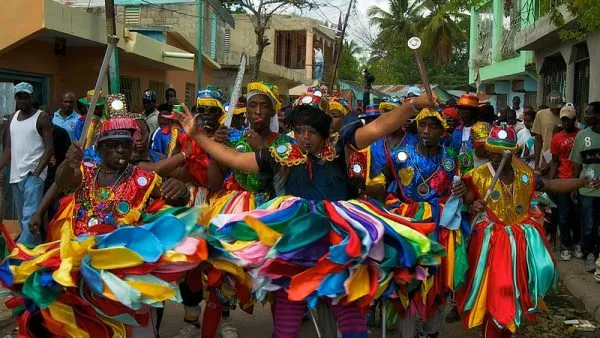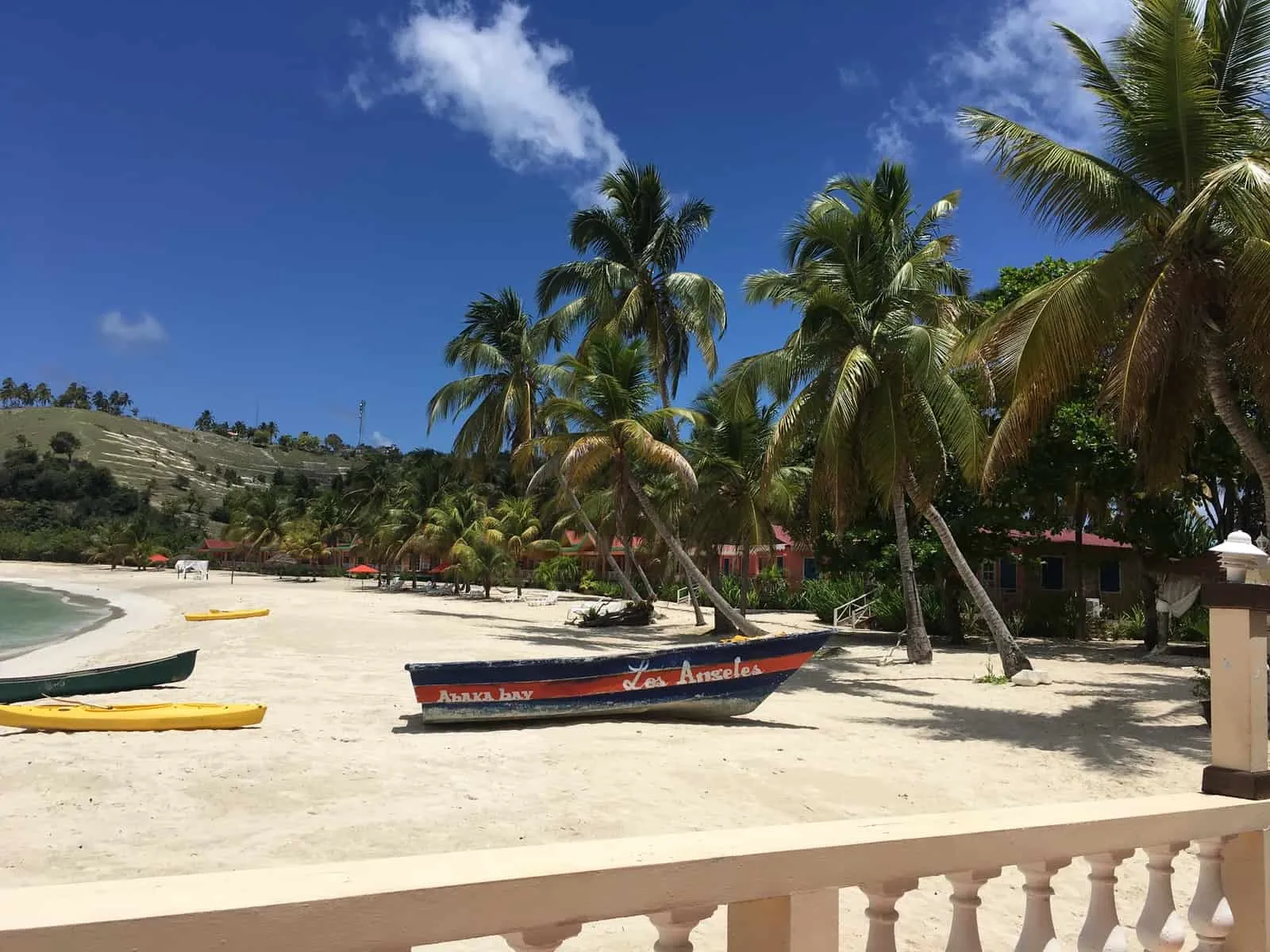Haitian music combines a wide range of influences drawn from the many people who have settled on this Caribbean island. It’s rich in history with many influential powers, including the Spanish, African, French, British, and Spanish.
Haitian music is mostly a unique blend of French and African culture. It has been passed down through the generations, with influences from other Caribbean countries. Afro-Cuban jazz is one of the styles that has influenced Haitian musicians today.
Kompa
Kompa is a popular misspelling of Haiti’s national music, compas. Kompa is a fusion of calypso, reggae, and Haitian folk music. It is often danced to and sung in social gatherings, especially in the rural areas of Haiti.
Compas, which is typically described as a “modern merengue,” is wildly popular throughout the entirety of the Caribbean.
Though Nemours Jean Baptiste’s contributions to the genre have made compas direct more associated with Haiti, the style is rooted in the region as a whole.
Nemours Jean Baptiste and Webert Sicot popularized compas music through their tours and performances in the late 1950s. They were saxophone and horn players, respectively. Weber and Nemours were also good friends.
After establishing a vision, the duo created their genre-changing group, “Conjunto International.” Jean Baptiste and Sicot traveled around the Caribbean, influencing others with a new and jazzier take on Haiti’s fortuitous meringue.
Conjunto International’s konpa dirèk was a hit. Kompa, also considered Haitian music, is characterized by its upbeat tempo, syncopated rhythms, and lively nature.
People of all ages enjoy the popular Haitian kompa style of music. The music is often used to celebrate events and occasions and is popular among dance clubs and nightlife venues.
In the 1950s, when traditional kompa was most prevalent, audiences would often dance in a square. This tradition is still alive today and can be seen at Haitian festivals and concerts.
This dance originates from the Caribbean and is characterized by its fast tempo and strong rhythm. It is often danced to traditional Haitian music, known for its lively and festive atmosphere.
Konpa dirèk was so popular in the Haitian (and Caribbean) music scene that it spawned several new musical derivates and genres. Outside the direct and intentional deviation of Webert Sicot via his creation of cadence rampa, there were also strong compas influences in mini jazz, cadence-lypso, and coladeira.
The mini jazz style unique to Haiti is defined by its blendings of kompa. Exile One, a quintessential Dominican cadence-lypso group from the 1970s, was heavily influenced by konpa in creating the style that coined the unique cadence format.
In the 1980s, Haitian music began to spread to Cape Verde. At the time, American rock and French meringue were the most popular genres of music in the country.
Kompa, popular Haitian music based on percussion and dance, was trendy in Cape Verde. Today, Haitian music is still prevalent in Cape Verde, and there are festivals dedicated to its performance every year.
Kompa music is widespread throughout the Caribbean and has gained popularity in the United States. The style of music is typically based around percussion instruments, including drums, congas, and timbales.
The rhythms are often syncopated and include Haitian folk songs and dance rhythms. The lyrics are often about love, dance, and social commentary.
Méringue
Méringue is a guitar-based style historically connected to merengue. Méringue is a faster-paced, more upbeat style of music that originated in Haiti. Méringue is typically played at carnivals and festivals and is often used as the main musical accompaniment for Haitian dance performances.
Méringue has been gaining popularity in the United States, and there are now several Méringue bands playing around the country.
The popularity of dance music played on simple acoustic instruments such as the méringue, which is now losing popularity to the similar kompa style of music but with the addition of the accordion, is a result of the blending of African European cultures.
Rara
Rara music is Lenten processional music with solid ties to Vodou religious tradition. The music is typically slow and solemn and often features unaccompanied vocals or simple instrumentation.
Rara musicians often dedicate their work to honoring their ancestors, and they often perform in remote villages or churches without electricity or other modern amenities.
Both celebrations involve large groups of dancing people in the streets
Haitian music is often associated with celebrations. Many Haitian celebrations involve large groups of dancing people on the roads.

It often leads to confusion about which one is taking place- the popularization of Haitian music in the Caribbean or the passion and dedication of those who practice and perform it.
Rara Celebration typically occurs between Ash Wednesday and Easter Sunday. It is a time when Haitians come together to sing, dance, and enjoy each other’s company.
This celebration is unique because it is the only time of year when Haitians can freely express their emotions. Rara bands are roaming the streets performing religious ceremonies as part of their ritual obligations to the spirits of Haitian Vodou.
Guédé is an essential spiritual presence in Rara celebrations. Guédé is the spirit of the forest and is often invoked during Rara ceremonies to help protect the community and ensure a successful harvest.
Guédé is also a powerful healer and is often called upon to help treat illnesses and injuries. Before the band begins its procession, it often possesses a houngan or mambo blessing the participants and wishing them safe travels for their nightly sojourns.
Mini jazz
Mini-jazz is a style of music that’s been around for a long time, but it’s really seen a resurgence in popularity recently. It typically consists of two guitars, bass, drums, conga, and cowbell. Sometimes you’ll find an alto saxophone thrown in there as well.
All these small rock bands seemed to have intricate guitar tones. In the 1970s, jazz music was released in mini-styles still using a variant of the méringue style. One of those mini-jazz bands, Tabou Combo, became one of the most popular groups in
Rock Kreyol
In the early 1960s, Haitian rock bands called yeye performed rock ‘n’ roll in Haiti. These bands directly responded to rock ‘n’ roll in the United States.
The yeye bands were a vital part of the Haitian cultural revolution, which sought to break away from traditional Haitian music. The yeye bands helped popularize rock ‘n’ roll in Haiti and helped create a new generation of Haitian musicians.
Rasin
Rasin is a style of Haitian music that is popular in the Caribbean. It is a type of dance music that is often played at Carnival. Rasin is also sometimes used to accompany Haitian folk dances. Rasin is a Haitian punk movement that isn’t conservative musically, politically, or socially.
To better understand the genre, we should look into its origins. We can see how this genre came to be in Haiti with Jean-Claude Duvalier.
The arrival of Christianity in Haiti during the 17th century led to new practices and customs. Though voodoo is deeply rooted in Haitian culture, Rasin is a mix of traditional voodoo music and the aggressive sound of European brass instruments, which were introduced by Christian missionaries.
Racin is a type of Haitian music like gospel music that uses call-and-response singing. The lead singer will sing a line, and the audience will repeat it.
Racin’s lyrics generally follow one of two paths: either they speak of voodoo-inspired ideas of sneakiness, betrayal, judgment, and reclaiming one’s roots, or they criticize the horrendous military practices of the past and boast about their riches.
Other racing pieces are strictly religious, praising Voodoo deity or used for worship. And still, others are crafted for simple fun and dance. Songs are usually sung in Haitian Creole.
A musical genre with a heavy focus on voodoo originated from Africa, including rada and petwo.
The rada and petwo drums have different purposes. Rada is supposed to give a sense of chilliness, while the petwo drums create a fiery heat. The two drum lines are never used within the same song but are often alternated instead.
Some elements of rock and roll include instrumentation – electric guitars, horns, keyboards, basses, and drums. The lyric structure is also a part of rock and roll.
Haitian hip hop rap kreyòl
Haitian hip hop rap kreyòl is a unique form of music that is often misunderstood by outsiders. It is a vibrant and passionate genre steeped in history and tradition.
Haitian hip hop rap kreyòl is often compared to reggae, but it has its own unique flavor. The lyrics are often poetic and reflective, and the beats are typically fast and hard-hitting.
Many of the biggest names in Haitian hip hop rap kreyòl are currently based in the United States. However, the genre is still trendy in Haiti, often used to express political and social messages.
The lyrics are often critical of the government and society, and they often advocate for change.
Rap music has become increasingly popular in Haiti among both young and old, as it has become a way for the youth to communicate social and political topics.
Rap music has been used to express anger and frustration over the government’s neglect of the population and call for change. The lyrics often deal with social issues such as poverty and violence, and the music is usually fast and aggressive.
Gospel Music
Haitian gospel music is a genre of music that is popular in Haiti. It is often sung in Haitian Creole and is influenced by traditional Haitian religious music. Gospel music in Haiti is often used to promote religious worship and spread God’s word.
Haitian gospel music is rooted in the rise of Christianity on the island, and Haitian gospel music has since become a popular genre on the island. The music is often sung in Haitian Creole and often features spiritual lyrics about the power of faith. Haitian gospel music is often used as an instrument of social activism and has been used to raise funds for charity events.
Haitian gospel music, known in Creole as “levanjil mizik,” is rooted in the rise of Christianity on the island nation and has a long history. Missionaries first came to Haiti and introduced their religion through song.
Although Christianity was initially rejected by Haitians, it eventually grew popular due to its ability to provide hope during challenging times.
The Haitian revolution, a struggle for independence that spanned the period of 1791-1804 owes its origins to the French colonial regime. With their ruling prowess, the colonizers insisted that the Haitian natives and imported enslaved Africans around them practiced devoutly.
The Spanish missionaries were primarily Catholic, and they came to convert the indigenous people in the Americas. They were sent to the Americas by their superiors, and they traveled across it spreading Christianity. As they did so, new diseases emerged that would affect many groups of people.
The African island of Haiti has been a part of many different empires for centuries. France has had a long and complicated history with Haiti, which eventually led to them taking over the European administrative head of the country in the 1700s.
The French ruled Haiti for over two hundred years before finally giving up control in the 1800s. In the mid-1800s, the second wave of Haitians began to immigrate to Louisiana. They brought with them the religion of Vodou and voodoo drumming.
Vodou is a religion that expresses worship through dance, drumming, and song. Voodoo drumming is primarily focused on African rhythms and percussion.
Haiti is one of the few countries in the Western world that practices a form of Christianity different than Catholicism. The country was introduced to Protestantism by the Americans after they gained independence from France in 1804.
Haitian gospel music is a more outgoing form of worship within the Haitian Rara traditions. The style has spread through Haiti due to its popularity. Rara is a form of music that originated in Haiti, and it is characterized by its use of vocal harmonies.
Twoubadou
Troubadour Music is the traditional music of Haiti and a more recent type of Haitian folk music. The word “twoubadou” is derived from troubadour, meaning medieval poet-musician.
The guitar has been a popular instrument throughout the history of Troubadour Music in Haiti. The Haitian troubadour is a singer-composer who plays a twoubadou that tells love stories, usually involving risqué or suggestive lyrics.
The Haitian people are known to be the most musical in the world, and the twoubadou is one of many instruments that has evolved over time to tell these stories.
The traditional Twoubadou song is structured similarly to a conventional Spanish troubadour’s piece. A song usually consists of a chorus followed by two verses sung in Haitian Creole, Spanish or French.
The chorus is repeated between verses, and the song ends with a brief “Aaha!” expression. Many people think that the accordion is only for Irish folk music, but it is also used in popular music.
The accordion creates a uniquely full and rich sound, and its bellows are more pliable than most other instruments, which means that they can produce a broader range of tones.
Accordions also can do polyphonic playing, which means they can play two or A lamellophone is often used to provide a bass line while a maraca, barrel drum, or scraped instrument is used to hold the rhythm.
Haitian Voodoo Drumming
Haitian Voodoo Drumming is a centuries-old tradition that is still practiced today. The drumming is used to communicate with the spirits and summon them to help in a person’s life.
The drums are also used in ceremonies to bless the participants and protect them from harm. Vodou is an essential and stigmatized religion distinctly Haitian in origin and affect.
It is a syncretic faith that draws from various sources, including Roman Catholicism, Protestantism, and African traditional religions. Vodou is practiced by a large percentage of the Haitian population, and it is an integral part of Haitian culture.
Haitian Voodoo drumming is a centuries-old tradition that has been profoundly influential in genres like rara and rock Kreyol. The musical elements found in Haitian Voodoo drumming have undeniably influenced these popular styles and continue to this day.
The rhythmic patterns found in Haitian Voodoo drumming are often complex and syncopated, and they feature a large number of claves (a type of percussion instrument made out of a single piece of wood).
These claves play an essential role in Haitian Voodoo drumming, as they are used to create the syncopated rhythms that are so characteristic of the style.
Haitian voodoo drumming is a unique form of music often associated with the supernatural. The drums are used to create a rhythmic base and accompany the vocals.
Percussion instruments, such as the djembe, conga, and timbales, are integral to this type of music. Haitian voodoo drumming is often performed in religious ceremonies or folkloric celebrations.
There are many styles of Haitian music, and each one has its own unique sound. In this post, we highlighted some of the most popular Haitian styles. These styles are often associated with the specific age groups of Haiti, and they vary in terms of popularity and complexity.
If you’re interested in exploring Haitian music further, there are plenty of resources available online. You can find music videos, audio recordings, and even learning materials for various styles.



